 The
"Tardiana" Group of hostas was developed by
Eric Smith (1917-1986) in
England . It consists of many blue colored hybrids of
H. 'Tardiflora' × H.
sieboldiana 'Elegans'.
This was a very unique cross since one normally blooms
in
early season while the other flowers in the fall. One year, the
early flowering H. 'Elegans' decided to put on a few re-blooms late in the
year allowing Smith to cross breed it with H. 'Tardiflora'.
The most famous resulting cultivar is H. 'Halcyon' which has been used in
hybridizing many new cultivars.
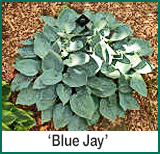 To view a list of the original seedling numbers
assigned to these plants,
Click Here. To view a list of the original seedling numbers
assigned to these plants,
Click Here.
Members of this group of hostas have rich blue-green foliage and
are generally about medium size. Its leaves have 12-13 pairs of
veins. The Tardianas produce pale lavender flowers in clusters
during the late July to mid-August period of the summer.
 Noted hosta collector,
Peter Ruh amassed 39 of Smith's plants between
1979 and 1988. In accordance with correspondence
with Smith, Ruh then went on to registered them. He
obtained the plants from
Julie Morss (11 of them),
Alex Summers (7),
Paul Aden (5),
Beth Chatto (1),
Peter Paris (1),
Ken Anderson (2),
Handy Hatfield (2),
Sandra Bond (1),
Mrs. Stevens (1)
Russ O’Harra (1),
Roger Bowden (2)
Dr. Ullrich Fischer
(1), and traded with
Wisley Botanical Gardens for four
plants. Noted hosta collector,
Peter Ruh amassed 39 of Smith's plants between
1979 and 1988. In accordance with correspondence
with Smith, Ruh then went on to registered them. He
obtained the plants from
Julie Morss (11 of them),
Alex Summers (7),
Paul Aden (5),
Beth Chatto (1),
Peter Paris (1),
Ken Anderson (2),
Handy Hatfield (2),
Sandra Bond (1),
Mrs. Stevens (1)
Russ O’Harra (1),
Roger Bowden (2)
Dr. Ullrich Fischer
(1), and traded with
Wisley Botanical Gardens for four
plants.
There is also a group of hostas called the "German
Tardianas". Eric Smith sent
Heniz Klose of Germany a group of Tardiana
seedlings. Klose nameds some of them and others were
named by Peter Ruh and others listed above. We have gathered over 100
hosta cultivars in our database that are
noted as being "Tardiana-type" hostas. Some of those listed are
from the original breeding lines that started with Eric Smith.
Others are plants that have some or all of the classic traits of
Tardiana hostas in their color, leaves and flowers but are not
part of the original line of plants.
 The
name "Tardiana" is a composite word taken from the "Tard"
in 'Tardiflora' and the "iana" from 'Sieboldiana'. The
name "Tardiana" is a composite word taken from the "Tard"
in 'Tardiflora' and the "iana" from 'Sieboldiana'.

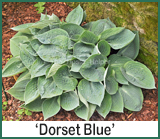 The
Hosta Journal (1993 Vol. 24 No. 2) contained an article
by
Dr Bob Olson regarding a visit he and others made to the garden
of
Dr Ralph (Herb) Benedict. "We spent the afternoon looking at the
end result of his marvelous hybridization scheme. Dr. Benedict would
recite the perfect logic by which such crosses were conceived and
executed. Tardianas to the F-6
generation were created by crossing the most fertile of one hundred
'Dorset Blue's with their
most fertile offspring. The
Hosta Journal (1993 Vol. 24 No. 2) contained an article
by
Dr Bob Olson regarding a visit he and others made to the garden
of
Dr Ralph (Herb) Benedict. "We spent the afternoon looking at the
end result of his marvelous hybridization scheme. Dr. Benedict would
recite the perfect logic by which such crosses were conceived and
executed. Tardianas to the F-6
generation were created by crossing the most fertile of one hundred
'Dorset Blue's with their
most fertile offspring.
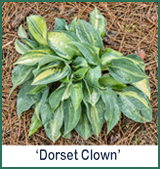 He ended up creating more new Tardianas than
Eric Smith had done. (Smith was thwarted at the F-3 generation
when he ran into relatively sterile plants.) The blues Dr. Benedict
chose to name are all rather small and very blue indeed. In order of
decreasing size: 'Blue Jay', 'Blue
Ice', 'Blue Chip', and
the smallest of the lot 'Blue
Urchin'...Somehow in his crosses he came up with a pure Tardiana
hybrid which is streaked and splashed - and give variegated
seedlings (often fifty percent or more)...he produced a 'Dorothy
Benedict'-like-Tardiana, 'Dorset
Clown'. The possibilities of this plant ignited our
imaginations: can you envision a whole series of variegated Tardiana
offspring?" He ended up creating more new Tardianas than
Eric Smith had done. (Smith was thwarted at the F-3 generation
when he ran into relatively sterile plants.) The blues Dr. Benedict
chose to name are all rather small and very blue indeed. In order of
decreasing size: 'Blue Jay', 'Blue
Ice', 'Blue Chip', and
the smallest of the lot 'Blue
Urchin'...Somehow in his crosses he came up with a pure Tardiana
hybrid which is streaked and splashed - and give variegated
seedlings (often fifty percent or more)...he produced a 'Dorothy
Benedict'-like-Tardiana, 'Dorset
Clown'. The possibilities of this plant ignited our
imaginations: can you envision a whole series of variegated Tardiana
offspring?"

Noted nurseryman and hybridizer,
Bob Solberg in
The
Hosta Journal (1994 Vol. 25 No. 2) states that "Eric
Smith...created a new color in hostas as well as
several new leaf forms. The dark green base color
from H. 'Tardiflora' overlayed with the white
H. 'Elegans' wax resulted in the
bluest hostas to date. The Tardiana grex, introduced
in the mid-1970s, not only gave us a group of
beautiful hostas with increased substance, but gave
hybridizers the encouragement to try more
"out-of-season" crosses and expect breakthrough
combinations."

 An article by Warren I. Pollock in
The
Hosta Journal (1997 Vol. 28 No. 1) states that, "H. 'Blue Blush' is described in nursery catalogues as "small" or "dwarf." In fact,
when mature it is neither small nor dwarf. As a young plant, 'Blue Blush' is
small, perhaps an 8-inch mound. But after about 5 or so years, it takes off and
becomes a medium size plant. The 'Blue Blush' registration by the
British Hosta
and Hemerocallis Society if for a young - not mature - plant...Sandra
Bond says that if you want to keep 'Blue Blush' small, keep dividing it. She
adds that 'Hadspen Heron', another in the Tardiana Group, responds in the same
way." An article by Warren I. Pollock in
The
Hosta Journal (1997 Vol. 28 No. 1) states that, "H. 'Blue Blush' is described in nursery catalogues as "small" or "dwarf." In fact,
when mature it is neither small nor dwarf. As a young plant, 'Blue Blush' is
small, perhaps an 8-inch mound. But after about 5 or so years, it takes off and
becomes a medium size plant. The 'Blue Blush' registration by the
British Hosta
and Hemerocallis Society if for a young - not mature - plant...Sandra
Bond says that if you want to keep 'Blue Blush' small, keep dividing it. She
adds that 'Hadspen Heron', another in the Tardiana Group, responds in the same
way."

Writing about H. 'Canadian Shield', H. 'Devon Green', H. 'Peridot' and H.
'Valerie's Vanity' by Warren I. Pollock in
The
Hosta Journal (1997 Vol. 28 No. 1) states that, "These
four hostas are mutations of 'Halcyon', arguably the best of the late
Eric
Smith's blue-leaved Tardiana Group...Are all four cultivars the same? I haven't
seen any evidence they are different."

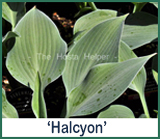 An article about the Halcyon Group by
Peter Cross in
The
Hosta Journal (2004 Vol. 35 No.2) says, "Though
'Halcyon' is not the bluest hosta now available, no blue hosta has yet to match
the balance of color, size, habit and growth rate that has made 'Halcyon' the
classic medium-sized blue hosta...One simply doesn't have a hosta collection
until it contains at least one clump of 'Halcyon'. ..is a first-generation member
(TF 1 × 7) of the legendary
Tardiana Group of hostas, which consists of hybrids
of 'Tardiflora' × H. 'Elegans', produced in
England by
Eric Smith,
the master hybridizer of blue hostas, in the 1960s. An article about the Halcyon Group by
Peter Cross in
The
Hosta Journal (2004 Vol. 35 No.2) says, "Though
'Halcyon' is not the bluest hosta now available, no blue hosta has yet to match
the balance of color, size, habit and growth rate that has made 'Halcyon' the
classic medium-sized blue hosta...One simply doesn't have a hosta collection
until it contains at least one clump of 'Halcyon'. ..is a first-generation member
(TF 1 × 7) of the legendary
Tardiana Group of hostas, which consists of hybrids
of 'Tardiflora' × H. 'Elegans', produced in
England by
Eric Smith,
the master hybridizer of blue hostas, in the 1960s.

 ...The first sport...was aptly named 'Goldbrook Glimmer', discovered by
Sandra
Bond of Goldbrook Plants in
England...features
a narrow
"glimmer" or blaze of green down the middle
of the blue leaves...The variegation is most
pronounced in cooler climates and early in the
season...In especially warm climates, the mound will
appear a solid blue by the end of the summer. ...The first sport...was aptly named 'Goldbrook Glimmer', discovered by
Sandra
Bond of Goldbrook Plants in
England...features
a narrow
"glimmer" or blaze of green down the middle
of the blue leaves...The variegation is most
pronounced in cooler climates and early in the
season...In especially warm climates, the mound will
appear a solid blue by the end of the summer. ....I have difficulty choosing a single favorite hosta but, when I am
pressed, more often than not H. 'June' is my choice. This queen of hostas is the
best-known sport of 'Halcyon', taking the dusty blue leaves of the parent and
adding a splash of yellow to the centers of the leaves...As with 'Goldbrook Glimmer', climate plays a huge part in the appearance of 'June'. It needs a
little bit of direct sun early in the season to bring out the brightest
golden-yellow tones in the centers of the leaves, while cooler temperatures are
needed for the best blue coloration. (Specimens of 'June' that I've seen in
Britain and
New Zealand surpass all description.)"

Here are the Tardiana-type hostas that we have in
our database in alphabetical order by the name of
the cultivar.




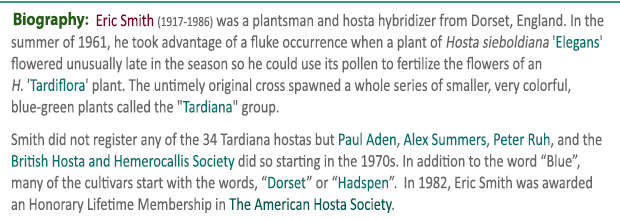
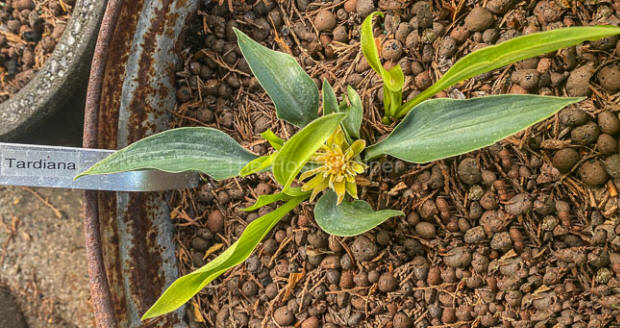









|



